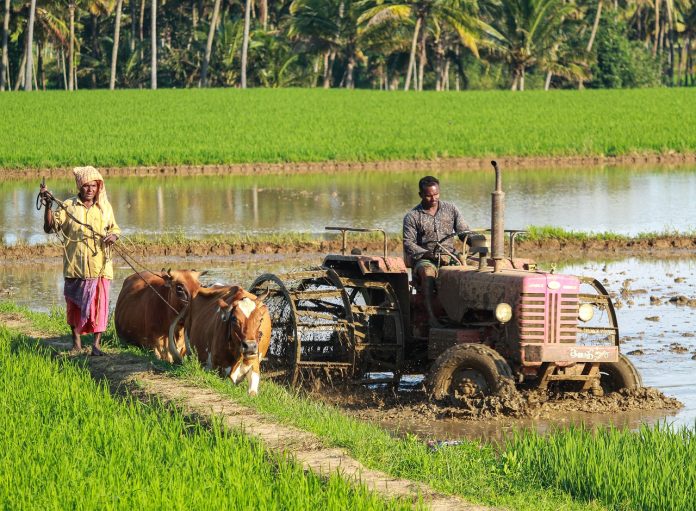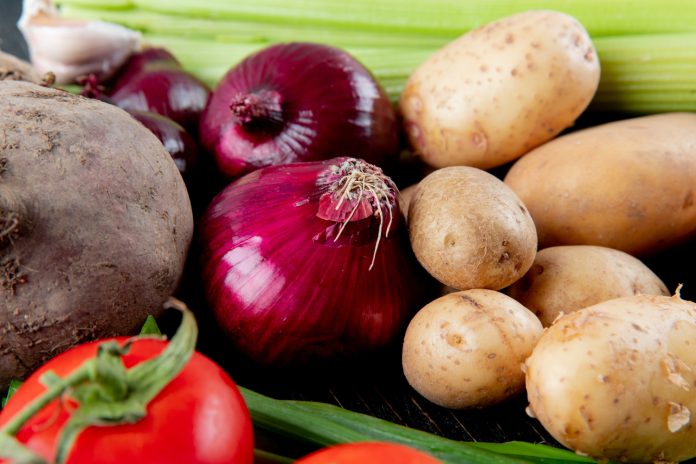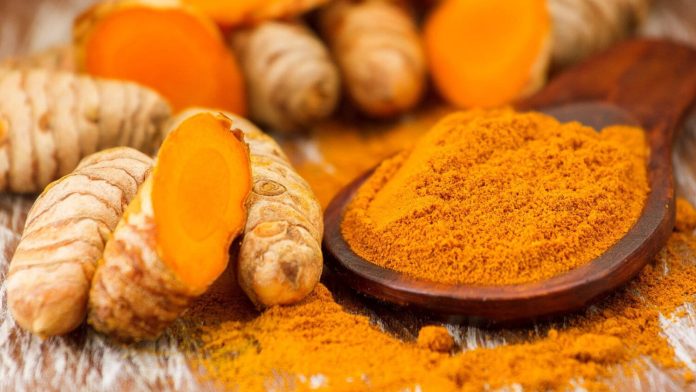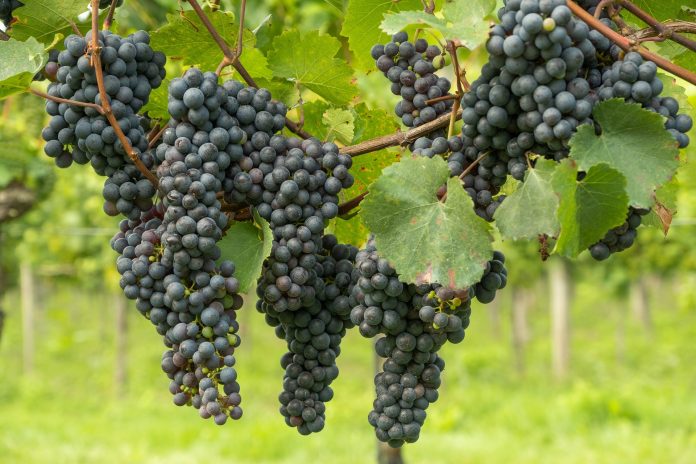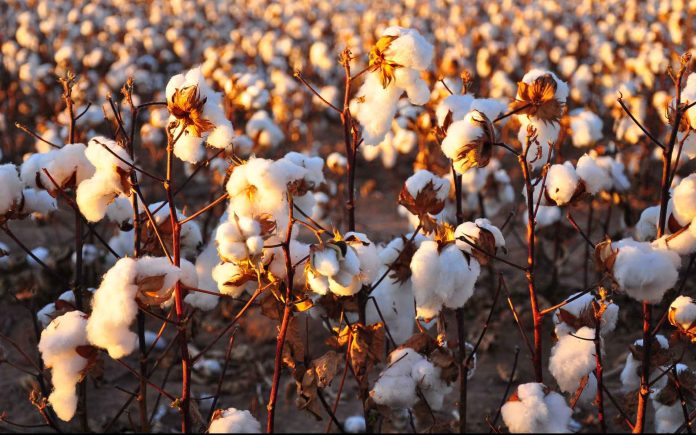Did you know that during the year 2022, the volume of turmeric production in India reached an astonishing 1.33 million metric tons?
This remarkable achievement highlights the immense opportunities that lie within turmeric cultivation. If you’re a farmer seeking to capitalize on this thriving market, you’ve come to the right place! Get the complete package of practices of turmeric at one place.
Turmeric, also known as Indian saffron, holds immense value and demand across various sectors. Not only is it used as a condiment, dye and part of religious ceremonies, but it has also gained significance in the drug and cosmetic industries due to its medicinal properties. The versatility and widespread use of turmeric ensure a consistent demand, making it a profitable crop to cultivate. So, don’t hesitate to embrace the benefits of turmeric farm. Learn in detail on how to grow turmeric crop to increase your farm productivity.
Turmeric Crop at a Glance
Botanical Name: Curcuma longa
Vernacular Names: Haldi (Hindi), Manjal (Tamil), Pasupu (Telugu), Arishina (Kannada), Manjal (Malayalam), Halud (Bengali), Haladi (Punjabi), Halada (Marathi).
Crop Season: Kharif season
Crop type: Spice crop
Crop Duration: 7 – 9 months
Climate
Turmeric cultivation can be done in diverse tropical regions with warm and humid climates. Ideally, it requires an annual rainfall between 1500 mm. It can be grown within a temperature range of 20 to 35°C. Slow emergence of the pseudostem and leaves may occur when the temperature is high, and humidity is low.
Soil
Turmeric can grow in various soil types however, it exhibits optimal growth in well-drained soils, particularly red or clay loam soils. These soils should ideally have a pH ranging from 4.5 to 7.5 and possess good organic content.
Pick and Cultivate Your Region’s Best Varieties
| States |
Varieties |
| Tamil Nadu |
CO1, BSR 1, BSR 2, Erode local, Salem local |
| Karnataka |
Kasturi, Mundaga, Balaga, Yalachaga |
| Andhra Pradesh |
Duggirala, Kodur type, Sugantham, Kasturi, Tekurpeta, Pragati, Nizamabad bulb, Armor |
| Maharashtra |
Sangli, Rajapore, Kolhapur |
| Telangana |
Roma, Suroma, Rajendrasonia, Ranga, Pragathi, Armoor |
| Kerala |
Allepey, Sudharsana, Suvarna, Wynad |
| Orissa |
Jobedi, Dughi, Katigia, Ranga, Suroma, Roma |
Field Preparation for Turmeric Cultivation
After receiving the early monsoon showers, prepare the land by giving it about four deep ploughings to bring the soil to a fine tilth. They apply hydrated lime at a rate of 200 – 400 kg/acre for laterite soils, considering the soil pH, and then thoroughly plough the lime into the soil.
In case your field has light soil, prepare beds of 1 m width, 30 cm height and of convenient length adopting 50 cm spacing between the beds. If your field has heavy soil, then form ridges and furrows.
Rhizome Selection
Select well-developed, healthy and disease-free rhizomes for cultivation. Use whole or split mother and finger rhizomes for turmeric planting. The mother rhizome can be divided into two or three pieces, each containing one or two healthy buds and used as seed material.
Seed Rate
- Mother Rhizomes: 800 – 1000 kg per acre
- Finger Rhizomes: 600 – 800 kg per acre
- For inter-cropping: 160 – 200 kg per acre
Seed Treatment
Before cultivation of turmeric, treat the turmeric seeds (rhizomes) with a solution of Mancozeb 75% WP (3 gm per liter of water) for a duration of 30 minutes. After that shade dry the rhizomes for 3 – 4 hours and then plant. Alternatively, the rhizomes can be treated with Pseudomonas fluorescens at a rate of 10 gm/kg and Trichoderma viride at a rate of 10 gm/kg, followed by sowing.
When to grow Turmeric Crop
Turmeric planting time varies across different locations in India, depending on the receipt of pre-monsoon showers. Usually in Kerala and other areas along the West Coast where rainfall begins early, turmeric cultivation can commence during the months of April and May.
Spacing and Planting
- Beds: Make small pits with a hand hoe on the beds in rows with a spacing of 25 x 30 cm. Then fill the pits with well decomposed compost or cattle manure. Place the rhizomes in it and cover it with soil.
- Ridges and Furrow: Plant the rhizomes at a spacing of 25 cm between individual plants and 45 – 60 cm spacing between ridges.
Nutrient Requirement
Apply organic manures like FYM (8 t/acre) and Neem cake (80 kg/acre) as basal application by broadcasting and then ploughing at the time of field preparation. Also, apply neem cake (80 kg/acre) by top dressing at 45 DAP.
The general dose of NPK fertilizer recommendation for turmeric farm in the following states;
- Kerala – 24:20:49 kg/acre
- Andhra Pradesh & Telangana – 121:51:81 kg/acre
- Tamil Nadu – 51:24:36 kg/acre
- Orissa – 24:20:36 kg/acre
- Karnataka – 49:24:49 kg/acre.
Find the suitable recommendation for your region;
| States |
Fertilizer (kg/acre) |
| Urea |
SSP |
MOP |
| Time of Application |
| 45 DAP |
90 DAP |
120 DAP |
Basal |
45 DAP |
90 DAP |
120 DAP |
| Kerala |
17 |
17 |
17 |
125 |
27 |
27 |
27 |
| AP & Telangana |
88 |
88 |
88 |
319 |
45 |
45 |
45 |
| TN |
37 |
37 |
37 |
150 |
20 |
20 |
20 |
| Orissa |
17 |
17 |
17 |
125 |
20 |
20 |
20 |
| Karnataka |
36 |
36 |
36 |
150 |
27 |
27 |
27 |
(*AP – Andhra Pradesh; TN – Tamil Nadu; DAP – Days after Planting; SSP – Single Super Phosphate; MOP – Muriate of Potash. Apply the fertilizers at the base of the plant and then cover with soil.)
Micronutrient Application
If your turmeric farm has zinc deficiency, apply 10 kg zinc sulphate for 1 acre field as basal application. Spray Anshul Parivarthan micronutrient mixture at 1 gm per liter of water during 60 and 90 days after planting to get higher yield.
Irrigation
Irrigate the field before and after planting turmeric rhizomes. You can subsequently irrigate at 7 – 10 days interval depending on the soil type. Clayey soils require 15 to 23 irrigations, while sandy loams require around 40 irrigations in a conventional irrigation system. Stop irrigating the beds 1 month prior to harvesting. If drip irrigation system is installed, give irrigation on a daily or alternate-day basis.
Intercultural Practices
Mulching
After planting turmeric rhizomes, you should immediately mulch the crop with green leaves at a rate of 5 – 6 t/acre. Repeat the mulching process at 3 t/acre during 40 and 90 days after planting, after completing weeding, applying fertilizers, and earthing up.
Earthing up
Do earthing up, 6 months after planting turmeric rhizomes by lightly digging the soil to prevent the exposure of developing underground rhizomes to sunlight.
Weeding
Perform weeding three times at 60, 90 and 120 days after planting, depending on the weed intensity. To prevent weed infestation, apply Pendimethalin (1 – 1.2 lit per acre) or Oxyfluorfen (1 – 1.7 ml/lit water) as a pre-emergence treatment. This helps to keep the field weed free for a period of 3-4 weeks from the sowing date.
Inter Cropping and Crop Rotation
Can you believe that you can increase your farm output and boost your profits right in your very own turmeric farm, even before you harvest the turmeric itself?
It may sound too good to be true, but it’s absolutely possible. Grow inter crops alongside your turmeric crop and get these benefits without waiting for the turmeric to mature.
Crops suitable for different cropping system with turmeric;
- Mixed cropping: Redgram, sun hemp, chilli, colocasia, onion, brinjal, maize and ragi.
- Intercropping: Small onion (Increase fresh rhizome yield), maize/chilli/castor (Gives high economic returns). Planting turmeric as an intercrop in coconut and arecanut plantation can also be done.
- Crop rotation: In wetlands, rotate turmeric with crops such as rice, sugarcane or banana every 3 or 4 years. In garden lands, do crop rotations with sugarcane, onions, chilli, garlic, vegetables, pulses, elephant’s foot yam, wheat, ragi, and maize.
- Border crops: Castor and pigeon pea (Provides shade to turmeric)
Pest and Disease Management
Pests of Turmeric Crop
- Shoot borer
Symptoms: The larvae feed into the internal tissues by tunneling into the pseudo stems. Affected central shoot wither and presence of frass can be seen near the bore hole.
Management: Spray Coragen Insecticide (0.4 ml/lit water) or Takumi Insecticide (0.5 gm/lit water) or Tracer Insecticide (0.4 ml/lit water) during July – Oct.
2. Rhizome scale
Symptoms: Presence of light brown to grey, circular appearance of scale as a covering on the rhizomes. They suck the sap and cause shriveling and drying of rhizomes affecting its germination.
Management: Discard the infested rhizomes before storage. Dip the rhizomes in quinalphos solution (0.75 ml/lit water) for 20-30 minutes before storage and before sowing.
3. Minor pests (Thrips, Lacewing bug, Leaf feeding beetle)
Symptoms:
- Thrips and Lacewing bug infest leaves, leading to the rolling of leaves, a pale discoloration and gradual drying. Both are common pests during the post monsoon period.
- Leaf feeding beetle feed on leaves leaving behind parallel feeding marks. It infests during monsoon season.
Management:
Diseases of Turmeric Crop
1. Leaf spot
Symptoms: Presence of brown spots of different sizes on the upper surface of the young leaves. The spots may have grey or white centers. These spots may coalesce and cover the entire leaf later causing them to dry up.
Management: Spray Indofil M45 Fungicide (1.5 – 3 gm/lit water) or Blitox Fungicide (2 gm/lit water) at 14 days intervals.
2. Leaf blotch
Symptoms: Presence of small, rectangular, oval or irregular brown spots appear on either side of the leaves which later turn dark brown or dirty yellow giving “scorched appearance”.
Management: Spray Dhanuka M45 Fungicide (3 – 4 gm/lit water) or Blue Copper Fungicide (2gm/lit water) or Tilt Fungicide (1 ml/lit water) at 14 days intervals.
3. Leaf blight
Symptoms: Presence of necrotic patches having white papery center of different sizes on the leaf lamina. It later spreads over the entire leaf causing “blighted appearance”.
Management: Spray Indofil M45 Fungicide (1.5 – 3 gm/lit water) or Zerox Fungicide (1 ml/lit water) at 14 days intervals.
4. Rhizome rot
Symptoms: Initially, water-soaked lesions appear on collar region of affected pseudostem and causes rotting resulting in soft rot. Yellowing of tips of lower leaves spreading to entire leaf blade. In later stages, it causes withering, drooping and drying of pseudo stems.
Management: Follow crop rotation with legumes, cauliflower, cabbage and root vegetables. Treat the rhizomes with Blitox Fungicide at 2 gm/lit water for 30 minutes before planting. If you notice this disease in the field, drench the beds with Ridomil Gold Fungicide at 1 – 2 gm/lit water. Apply 1 – 2 kg of Trichoderma viride + 100 kg of FYM per acre at the time of planting.
5. Nematodes
Symptoms: Root knot nematodes feed on the tender roots, rhizomes and base of pseudostem leading to stunted growth, chlorosis, necrotic leaves and poor tillering. The infected rhizomes show water-soaked brown areas on the outer tissues along with root galls leading to rotting.
Management: Apply 61 kg of neem cake per acre. Grow marigold as border or inter crop. Apply Multiplex Safe Root Bio Nematicide at 2 – 5 kg + 500 kg of well decomposed manure by broadcasting. You can also apply this by drenching at 10 gm/lit of water.
Harvesting of Turmeric
- Turmeric can be harvested within seven to nine months, depending on the variety and sowing time. The typical harvest period falls between January and March.
- Harvesting indices: Leaves dry up and exhibit a light brown to yellowish coloration
- Harvesting method: Cut the plants close to the ground. Before digging, give light irrigation to the soil. For harvesting, dig the underground clumps of rhizomes with spade or digging fork. Separate the finger from mother rhizomes.
Yield from Turmeric Farm
- Fresh rhizomes: 10 – 12 t/acre
- Cured rhizomes: 2 – 2.5 t./acre
Preserving seed rhizomes
To store turmeric rhizomes for seed purposes, heap them under the shade of trees or in well-ventilated rooms and then cover with turmeric leaves. You can also store the rhizomes in pits with saw dust and sand along with Kanjiram leaves. For aeration, cover the pits with wooden planks with 1 or 2 openings.
To control scale infestations, dip the rhizomes in Quinalphos solution (0.75 ml/lit water) for 20-30 minutes. For preventing storage losses caused by fungi, dip them in mancozeb (3 gm/lit water) solution.
Post-harvest Processing
After the turmeric rhizomes are harvested, they undergo various post-harvest processing operations including boiling, drying and polishing to transform them into a stable commodity suitable for the market.
1. Boiling
The boiling of turmeric is typically carried out within 3 to 4 days after harvest. Boiling helps to destroy the vitality of the fresh rhizomes, eliminates the raw odor, reduces drying time and yields a uniformly colored product.
- Traditionally, a vessel made of galvanized iron sheet is used for turmeric boiling.
- The boiling is considered complete when a pointed stick can be inserted into the rhizomes with slight pressure.
- Other indications include the softness and easy breaking of the rhizomes when pressed between the forefinger and thumb, as well as a yellow interior instead of a red one.
- The optimal cooking time for fingers is 45 – 60 minutes, while mother rhizomes require around 90 minutes of boiling.
- Alternatively, an improved turmeric boiler using steam boiling technique can be used for this purpose.
2. Drying
Drying is crucial to prevent spoilage, mold growth, and to enhance the shelf life of the turmeric. Dry the cooked turmeric fingers by spreading them in thick layers, typically around 5-7 cm thick, on the drying floor under the sun. During night time or when there is no sunlight, either heap or cover the turmeric to protect it. The drying process can take 10-15 days for the rhizomes to become completely dry.
3. Polishing
Polishing is usually done manually by rubbing the dried rhizomes together or mechanically by power operated drums. This helps give the turmeric a smoother, more uniform texture and enhances its visual appeal. During the final stage of polishing, sprinkle turmeric powder to achieve an appealing appearance of the product.



